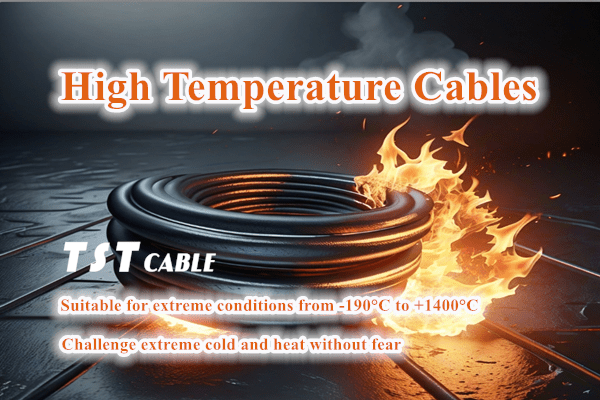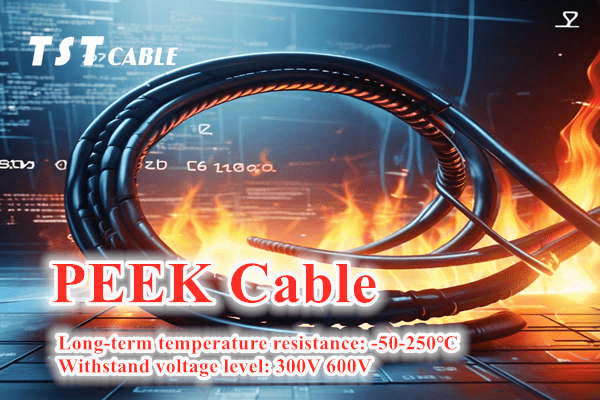In the previous article, we summarized the 10 plastic materials PVC/PE/XLPE/EPR/PTFE/FEP/PFA/TPU/TPE/silicone cables commonly used by cable companies and their characteristics and applications. Next, TST CABLES will continue to explore the other 10 cable plastic materials PET/PA/ABS/PMMA/PP/PVDF/LDPE/HDPE/PPS/PEEK cables commonly used by cable companies and their characteristics and applications.

11.PET cable (polyethylene terephthalate cable)
Features
Good insulation performance: PET has good electrical insulation performance.
Temperature resistance: suitable for a wide temperature range.
Chemical resistance: has good resistance to a variety of chemicals.
Transparency: has high transparency.
Application
Data communication: used for the insulation layer and sheath of data communication cables.
Control cable: used for the insulation layer of control cables.
Packaging materials: Although it is mainly used for packaging materials, it may also be used as an auxiliary material in some cables.
12. PA cable (nylon cable)
Features
Abrasion resistance: It has good wear resistance.
Oil resistance: It has good resistance to oils.
Chemical resistance: It has good resistance to a variety of chemicals.
Mechanical strength: It has high mechanical strength.
Application
Industrial cable: It is used for cables in industrial equipment, especially where high wear resistance is required.
Automobile cable: It is used for cables inside cars, especially where oil resistance is required.
Robot cable: It is used for cables that require high mechanical strength, such as robot arms.
13.ABS cable (acrylonitrile-butadiene-styrene copolymer cable)
Features
Good mechanical properties: ABS has high mechanical strength and toughness.
Chemical resistance: It has good resistance to a variety of chemicals.
Processing performance: It is easy to process and shape.
Flame retardant: It has certain flame retardant properties.
Application
Electrical equipment housing: Although it is mainly used for electrical equipment housing, it may also be used as a sheath material in some cables.
Industrial cables: Industrial cables that require high mechanical strength and flame retardancy.
Appliance cables: Cables used in household appliances, especially where chemical resistance and flame retardancy are required.
14. PMMA cable (polymethyl methacrylate cable)
Features
High transparency: It has extremely high transparency.
Good insulation performance: It has good electrical insulation performance.
Temperature resistance: It is suitable for a wide temperature range.
Chemical resistance: It has good resistance to a variety of chemicals.
Application
Fiber optic cable: It is used for the protective layer of fiber optic cable, especially where high transparency is required.
Medical equipment: It is used for cables in medical equipment that requires high transparency.
Precision instruments: It is used for cables in precision instruments that require high transparency.
15. PP cable (polypropylene cable)
Features
Lightweight: PP is a lightweight material.
Chemical resistance: It has good resistance to a variety of chemicals.
Temperature resistance: It is suitable for a wide temperature range.
Mechanical strength: It has certain mechanical strength.
Application
Low voltage cable: It is used for the insulation layer and sheath of low voltage power cable.
Communication cable: Insulation layer and sheath for communication cable.
Home appliance cable: Cable for home appliances, especially where light weight and chemical resistance are required.
16. PVDF cable (polyvinylidene fluoride cable)
Features
Chemical resistance: Excellent resistance to a variety of chemicals.
Temperature resistance: Applicable to a wide temperature range.
Flame retardant: Has good flame retardant properties.
Electrical properties: Has good electrical insulation properties.
Application
Chemical cable: Cable for the chemical industry, especially where chemical resistance and flame retardancy are required.
High temperature cable: Cable for high temperature environment.
Aerospace: Cable for the aerospace field, especially where chemical resistance and flame retardancy are required.
17. LDPE cable (low-density polyethylene cable)
Features
Flexibility: Good flexibility.
Chemical resistance: Good resistance to a variety of chemicals.
Temperature resistance: Applicable to a wide temperature range.
Processing performance: Easy to process and shape.
Application
Low voltage cable: Insulation layer and sheath for low voltage power cable.
Communication cable: Insulation layer and sheath for communication cable.
Home appliance cable: Cable for household appliances, especially where flexibility and chemical resistance are required.
18. HDPE cable (high-density polyethylene cable)
Features
Mechanical strength: High mechanical strength.
Chemical resistance: Good resistance to a variety of chemicals.
Temperature resistance: Suitable for a wide temperature range.
Processing performance: Easy to process and shape.
Application
High voltage cable: Insulation layer and sheath for high voltage power cable.
Industrial cable: Cable for industrial equipment, especially where high mechanical strength is required.
Communication cable: Insulation layer and sheath for communication cable.
19. PPS cable (polyphenylene sulfide cable)
Features
High temperature resistance: High temperature resistance.
Chemical resistance: Excellent resistance to a variety of chemicals.
Mechanical strength: High mechanical strength.
Flame retardancy: Good flame retardancy.
Application
High temperature cable: Cable for high temperature environment.
Chemical cable: Cable used in the chemical industry, especially in situations where high temperature resistance and chemical resistance are required.
Aerospace: Cable used in the aerospace field, especially in situations where high temperature resistance and chemical resistance are required.
20. PEEK cable (polyetheretherketone cable)
Features
High temperature resistance: It has extremely high temperature resistance.
Chemical resistance: It has excellent resistance to a variety of chemicals.
Mechanical strength: It has high mechanical strength.
Flame retardant: It has good flame retardant properties.
Application
High temperature cable: Cable used in high temperature environments.
Chemical cable: Cable used in the chemical industry, especially in situations where high temperature resistance and chemical resistance are required.
Aerospace: Cable used in the aerospace field, especially in situations where high temperature resistance and chemical resistance are required.
Summary
When cable companies choose cable plastic materials, they will decide based on the specific use and performance requirements of the cable. Each material has its own unique performance characteristics and scope of application. Choosing the right material can ensure the performance and reliability of the cable in a specific application. In practical applications, factors such as cost, processing difficulty, and environmental protection also need to be considered. Here are some specific examples:
Examples
1. High-voltage power cables: XLPE (cross-linked polyethylene) is usually used as the insulation material because it has high temperature resistance and high mechanical strength.
2. Communication cables: PVC (polyvinyl chloride) is usually used as the sheath material because it is low-cost and easy to process.
3. High-temperature environment cables: PTFE (polytetrafluoroethylene) or FEP (fluorinated ethylene propylene) is usually used because they have extremely high temperature resistance and good chemical resistance.
4. Medical equipment cables: Silicone is usually used because it has good biocompatibility and flexibility.
5. Industrial equipment cables: TPU (thermoplastic polyurethane) is usually used because it has high wear resistance and good chemical resistance.
By rationally selecting and using these materials, cable companies can produce high-quality cable products that meet the needs of various applications.
TST CABLES is suitable for extreme environments. Wear-resistant, oil-resistant, and bend-resistant TPU cables and TPE cables. The design of medical equipment cables fully considers the special requirements of the medical environment and can meet the various needs of medical equipment during use. Choosing the right cable type (2-core, 3-core, or 4-core) can ensure the normal operation of the equipment and improve the reliability and service life of the overall system. In actual applications, choosing the right cable according to the functional requirements and usage environment of the specific equipment can better exert its performance advantages. Our cables undergo rigorous quality testing to ensure that every detail meets the highest industry standards. We are committed to providing you with the highest quality products and services to ensure that each cable can operate stably in various harsh environments. If you have any needs for silicone cables, you are welcome to email TST CABLES engineers(Email:lixiangchao@testeck.com).
Also available in:
English





